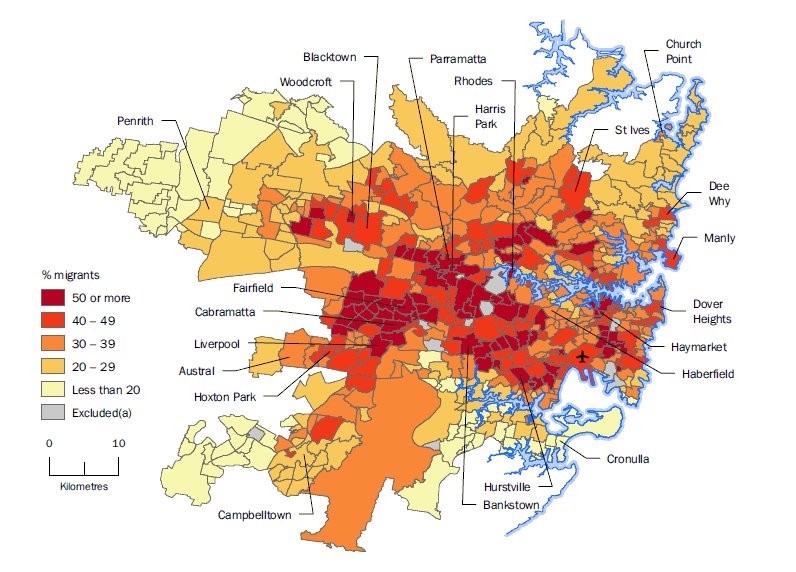
EJ Series, part 5: climate change, urban heat and ethnically diverse communities
By Phil McManus, Professor of Urban and Environmental Geography, The University of Sydney
The alteration of land surfaces across Western industrialised nations has caused urban areas to become significantly warmer than their surrounding rural regions. This phenomenon, known variously as Urban Heat or the Urban Heat Island (UHI), is caused by a multitude of factors including a lack of trees and vegetation in urban spaces; the abundance of cars, air conditioning and pollution from industry in urban areas; and the materials used to construct roads and buildings (see Argueso, et al., 2014, p.2197).
Urban heat impacts are increasing, especially in dense urban environments, and are rising faster than the rate of background climate change. Sharifi & Lehmann (2014, p.23) explain that “The Urban Heat Island (UHI) effect can result in higher urban densities being significantly hotter (frequently more than 4 °C, even up to 10 °C) compared to their peri-urban surroundings.” Whilst the issue of climate change is very important, there is a pressing need to acknowledge that climate change in conjunction with increased urbanization and the urban heat island effect, is impacting more people to a greater extent than previously understood.
When examining the issues surrounding urban heat and climate change, there is a need to acknowledge spatial justice issues. The urban heat effect is even more problematic when considering that these impacts will be disproportionately experienced by socially and economically disadvantaged people such as recently arrived migrants to Australia. In the context of Sydney, the vast majority of impacts associated with urban heat will be felt by migrants who reside in the Western Sydney region.
Census data (2016) from the Australian Bureau of Statistics (as indicated by the ABS map below), highlights that Western Sydney has high concentrations of people born overseas. In the largely populated Western Sydney suburbs of Fairfield, Bankstown, Cabramatta and Liverpool, the migrant population of these suburbs make up 50% of total residents, although not all are recently arrived.

Source: Australian Bureau of Statistics
Statistically, people born outside of Australia are more likely to be socially and economically disadvantaged and typically have underdeveloped infrastructure, resources and services to deal with the effects of urban heat. Migrants living in high density accommodation in parts of Western Sydney, often do not have access to, or the financial ability to use, cooling technology such as air conditioning. They may not have transport access to public spaces that are equipped to deal with, or deter, the effects of urban heat and anthropogenic climate change.
In the figure below, the dramatic increase in temperature in Western Sydney is outlined. This shows that the number of days exceeding 35 degrees Celsius each year increased by 250% in Western Sydney, compared to an increase of 22% in Sydney since 1965, and is on an upward trajectory.

Source: Greening Australia (Undated) The Urban Heat Island Effect and Western Sydney
The fact that the majority of urban heat is currently, and in the future will be, felt by the economically disadvantaged is an issue of environmental injustice that requires urgent attention. The three cities plan envisaged by the Greater Sydney Commission will only exacerbate urban heat problems in western and south-western Sydney unless these issues are addressed upfront. The cities envisaged by the Commission are the established Eastern City, the developing Central City around Parramatta, and an emerging Western City in and around the new airport at Badgerys’s Creek. According to the Commission, each of these three cities will have their own unique identity and needs, and each must be planned to maximise liveability, productivity and sustainability. Unless urban heat impacts are addressed in a concerted manner, the Western City will exacerbate urban heat concerns and the residents will suffer.
Therefore, if we are to address issues of environmental injustice experienced by migrant communities living in Western Sydney, there must be recognition and acknowledgement of these issues in strategic planning and policies decisions. These approaches already exist in areas locations that focus on establishing cool cities. Options as part of a policy framework include:
- The establishment of bodies of water in built up urban areas to allow for cool microclimates.
- Rethinking the use of brick, concrete, and asphalt in heavy urban areas, including the necessity of construction and the materials used when structures are needed.
- The development of greenspaces to help reduce and absorb greenhouse gas emissions.
- The inclusion of trees in civic spaces such as along sidewalks, to provide ‘shadeways’ that contribute to cooling urban heat islands and reducing energy consumption (McManus, 2007, 34).
Lastly, approaches to addressing spatial justice issues experienced by migrant communities must acknowledge the perspectives of migrants. Many migrants bring with them their experiences and practices of coping with heatwaves and extreme climate. As such, working with local residents to learn about their experiences of living and coping in hot environments can result in just approaches and their knowledge and experience of living in hot climates could also assist existing residents of Australian cities to live more sustainably.
Acknowledging the issue, and the disproportionate impacts, is the first step in working towards a response that involves the impacted residents as part of the solution.
- Argüeso, D., Evans, JP., Fita, L., Bormann, K. J. (2014). Temperature response to future urbanization and climate change. Climate Dynamics, 42(7-8), 2183–2199.
- McManus, PHIL. (2007). ‘Developing Sustainable Cities: Visions, Journeys and Trees (33-40).’ In David Lawry, Jennifer Gardner, and Sascha Smith (eds), Proceedings of the 8th National Street Tree Symposium: 6th & 7th September 2007.
- Sharifi, E., and Lehmann, S. (2014). ‘Comparative Analysis of Surface Urban Heat Island Effect in Central Sydney.’ Journal of Sustainable Development, 7(3), 23-35.
Phil McManus is a Professor of Urban and Environmental Geography, and the Head of School of Geosciences. He is a human geographer with interests in sustainable cities, environmental issues and human/animal relations.
Header image: by Kyle Bianchi via Unsplash.
